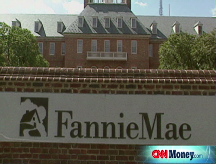It's crunch time for Fannie and Freddie
The two troubled mortgage giants are both expected to report big second-quarter losses. But can they convince Wall Street that they won't need a bailout?

 |
| Shares of mortgage financing giants Fannie Mae and Freddie Mac have plunged this year. But they've bounced back a bit from their lows in mid-July. |
NEW YORK (CNNMoney.com) -- Shares of Fannie Mae and Freddie Mac have both bounced back sharply from the lows they hit in the wake of last month's fears about their financial health.
We'll find out soon whether Wall Street's renewed faith in the two government sponsored mortgage giants is justified.
Freddie Mac (FRE, Fortune 500) will release its second-quarter results on Wednesday morning and its big sister Fannie Mae (FNM, Fortune 500) will report its second-quarter numbers before the opening bell on Friday. Both reports will be brutally ugly.
According to Thomson Reuters, analysts predict that Freddie Mac will post a quarterly loss of $404.6 million, or 53 cents a share. Fannie is expected to report a loss of $614.9 million, or 68 cents a share.
But it would probably be a pleasant surprise if the two companies simply met Wall Street's gloomy forecasts.
Both companies have lost money for the past three quarters as the housing downturn has taken its toll on each of them. Fannie has lost more than expected in each of those quarters while Freddie lost more money than forecast in both the third and fourth quarters of last year.
All told, Freddie Mac has lost more than $4.7 billion in the past three quarters while Fannie Mae has lost more than $7.1 billion during that time frame.
If either company misses forecasts badly, that could send the share prices, which have both nearly doubled since hitting 52-week lows on July 11, reeling once again.
And another steep sell-off would raise questions about whether the Treasury Department will need to use its newly granted power to lend more money to these two government sponsored enterprises (GSEs) or buy their stocks in order to back them up.
Treasury Secretary Henry Paulson and other Treasury officials have repeatedly referred to this rescue plan for Fannie and Freddie as a temporary backstop.
But some experts fear that if Fannie or Freddie do need to go to the government for further assistance, that could eventually lead to a nationalization of both firms. And the Congressional Budget Office has estimated that this worst-case scenario could cost taxpayers more than $100 billion.
Fannie and Freddie are crucial to the home-buying process in the U.S. since they buy pools of loans and package them into securities. This helps provide funding to lenders to make more loans. Fannie and Freddie own or guarantee about $5 trillion worth of mortgages.
The two companies need to be adequately capitalized in order to continue buying new loans and some fear that if the market dries up for their stock and debt, a full-blown government bailout would be absolutely necessary.
It's hard to imagine, given the weak state of the housing market, that Fannie or Freddie will be able to report decent quarterly results due to any improvement in the value of their loan portfolios.
"We believe that the GSEs will continue to have trouble with both credit losses and capital levels, and recommend that investors remain cautious on the names over the next few quarters. The housing bubble is still bursting, and the GSEs will not be left untouched," wrote Paul Miller, an analyst with FBR Capital Markets, in a research note this morning.
So with this in mind, Wall Street will be keeping a close eye on what Freddie and Fannie plan to do to cut costs in order to preserve capital as well as whether or not each company has new proposals to raise even more funding.
On the capital preservation front, there has been speculation that Fannie and Freddie could slash, or even suspend their dividend payments. Freddie already cut its dividend in half in the fourth quarter of 2007 and Fannie reduced its payout by 30% in the first quarter of this year..
But because shares of both companies have plunged about 75% this year, the yield on their dividends is still unusually high. Based on current prices, Fannie's $1.40 annual dividend yields 11.5% while Fannie's $1 payout yields about 12.5%.
"I'm not sure the dividends are safe. Given how high the yields are, I suspect the market is telling you something about future cuts," said John Snyder, manager of the John Hancock Sovereign Investors fund. The fund owns neither stock.
So there could be more room for the two companies to trim their dividends even further. And this would lead to meaningful savings.
After all, Freddie Mac paid about $1.6 billion in dividends to shareholders last year according to its annual report. Fannie Mae shelled out about $2.4 billion in dividend payments in 2007.
To be sure, eliminating the dividend entirely might be a bad move because some mutual funds that only own companies that pay dividends would be required to sell their Fannie and Freddie stakes.
That said, it wouldn't be a shock if Fannie and Freddie followed the lead of other troubled financials Washington Mutual (WM, Fortune 500) and National City (NCC, Fortune 500), which both cut their quarterly payouts to a so-called "token dividend" of just a penny per share.
But one thing is clear. Fannie and Freddie have to prove to Wall Street that they can raise capital on their own, and won't need to go running to Uncle Sam for it.
Issue #1 - America's Money: All this week at noon ET, CNN explains how the weakening economy affects you. Full coverage. ![]()







